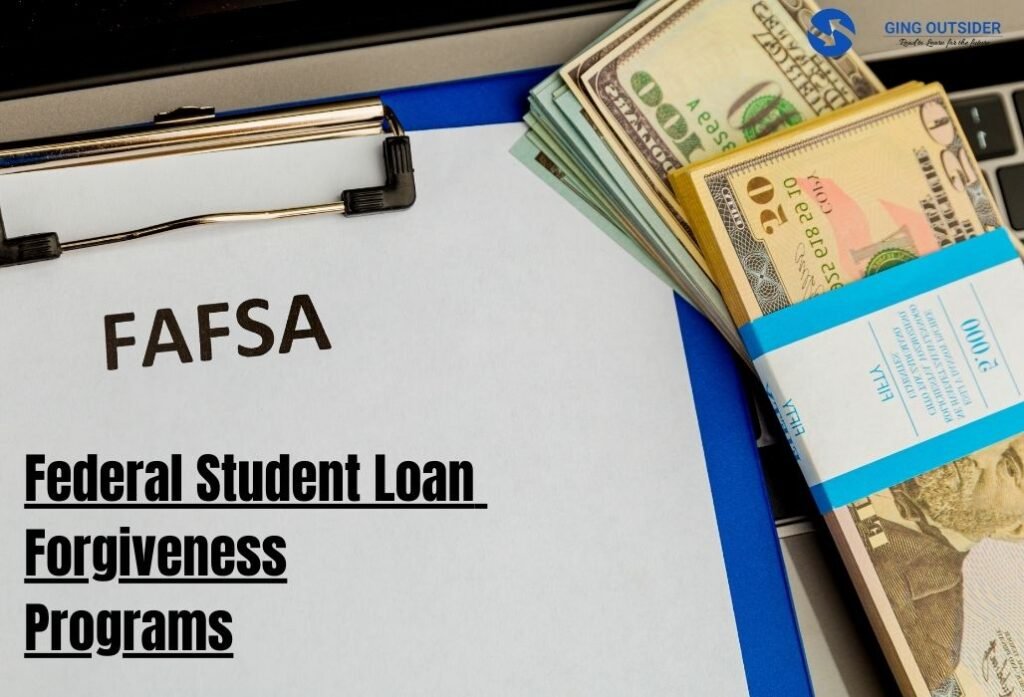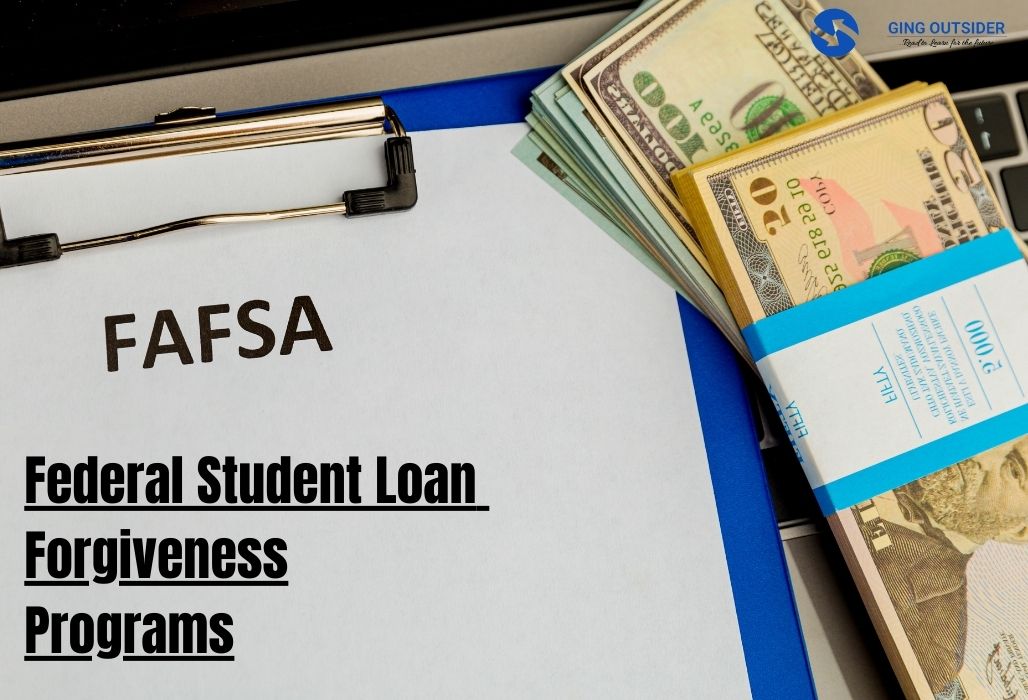Discover how federal student loan forgiveness programs can alleviate your student debt burden. Explore eligibility criteria, top programs, and tips for maximizing benefits in our comprehensive guide. Stay informed on recent updates and navigate FAQs for a clear understanding. Take control of your financial future today!

The burden of student loan debt is a significant challenge for many Americans, often hindering financial stability and personal growth. In response to this issue, the U.S. government offers various federal student loan forgiveness programs aimed at alleviating the financial strain on borrowers. This article will delve into what federal student loan forgiveness entails, how it works, the top programs available, eligibility criteria, tips for maximizing benefits, and recent updates. Additionally, we’ll explore the pros and cons of these programs and address common FAQs to provide a thorough understanding of this critical topic.
What is Federal Student Loan Forgiveness?
Federal student loan forgiveness refers to the partial or complete cancellation of student loan debt provided by the government to eligible borrowers. These programs aim to alleviate the financial burden on individuals who have taken out federal student loans to finance their education.
How Does it Work?
FSLF works by providing eligible borrowers with relief from their student loan debt under specific conditions. Depending on the program, forgiveness may be granted based on factors such as employment in certain professions, making a certain number of qualifying payments, or fulfilling service requirements.
The Top Federal Student Loan Forgiveness Programs You Need to Know
Meanwhile, here are the top types of student loan forgiveness programs.
- Public Service Loan Forgiveness (PSLF): Designed for borrowers working in qualifying public services jobs, such as government or non-profit organizations, PSLF offers forgiveness of remaining loan balances after making 120 qualifying payments while working full-time for an eligible employer.
- Teacher Loan Forgiveness: Aimed at teachers working in low-income schools or educational service agencies, this program provides forgiveness of up to $17,500 on Direct Subsidized and Unsubsidized Loans and Subsidized and Unsubsidized Federal Stafford Loans after five consecutive years of teaching.
- Income-Driven Repayment (IDR) Forgiveness: Borrowers enrolled in IDR plans, such as Income-Based Repayment (IBR), Pay As You Earn (PAYE), or Revised Pay As You Earn (REPAYE), may be eligible for forgiveness of remaining loan balances after 20 to 25 years of qualifying payments, depending on the plan.
- Perkins Loan Cancellation and Discharge: This program forgives a percentage of Perkins Loans for borrowers working in certain professions, such as teachers, nurses, or members of the armed forces, over a specified period.
- Military Service Loan Forgiveness: Members of the military may be eligible for various loan forgiveness programs, including the Military College Loan Repayment Program and the Loan Repayment Assistance Program for Reserve Component Soldiers.
Comparing Different Federal Student Loan Forgiveness Options
When considering federal student loan forgiveness options, borrowers should evaluate factors such as eligibility requirements, qualifying payments, forgiveness amounts, and service obligations. Each program has its own set of criteria and benefits, so it’s essential to compare them carefully to determine which one aligns best with your circumstances and career goals.
Pros and Cons
Moreover, here are the pros and cons of student loan forgiveness programs.
Pros:
- Provides relief from the burden of student loan debt
- Encourages individuals to pursue careers in public service, education, and other designated fields
- Offers financial flexibility by reducing monthly payments through income-driven repayment plans
- Enables borrowers to focus on achieving personal and professional goals without the constant pressure of debt
Cons:
- Limited eligibility criteria exist for certain programs, leading to the exclusion of many borrowers
- Potential tax implications for forgiven loan amounts, depending on the program
- Long-term commitment is required for some forgiveness options, such as PSLF and IDR plans
- Changes in legislation or program requirements may impact eligibility and benefits
Eligibility Criteria
To qualify for federal student loan forgiveness, borrowers must meet specific eligibility criteria outlined by each program. Common requirements include:
- Holding eligible federal student loans
- Working in qualifying employment or service
- Making timely payments while meeting other program-specific conditions
Tips for Maximizing Your Benefits from Federal Student Loan Forgiveness Programs
Furthermore, here are some tips to help you maximize your benefits from student loan forgiveness programs.
- Understand program requirements: Familiarize yourself with the eligibility criteria, payment requirements, and other conditions of the forgiveness program you’re considering.
- Stay organized: Keep track of employment certifications, payment documentation, and other required paperwork to ensure you meet program requirements.
- Optimize repayment plans: Enroll in income-driven repayment plans to lower monthly payments and maximize the amount forgiven over the repayment period.
- Explore employer assistance: Some employers offer student loan repayment assistance programs that can complement federal forgiveness benefits.
- Seek professional guidance: Consult with a financial advisor or student loan expert to develop a strategy tailored to your financial situation and career goals.
What to Do if You Don’t Qualify for Federal Student Loan Forgiveness
If you don’t qualify for federal student loan forgiveness, explore alternative options to manage your student loan debt effectively. These may include:
- Refinancing your loans to secure a lower interest rate and more favorable repayment terms
- Consolidating multiple federal loans into a Direct Consolidation Loan for simplified repayment
- Seeking assistance through loan deferment or forbearance if you’re experiencing financial hardship
- Prioritizing repayment by creating a budget and allocating additional funds toward your student loans whenever possible
Recent Updates and Changes in Federal Student Loan Forgiveness Policies
Federal student loan forgiveness policies are subject to change due to legislative updates, administrative actions, and other factors. Stay informed about recent developments that may impact your eligibility or benefits under forgiveness programs. Some notable updates include:
- Expansion of PSLF eligibility criteria to include borrowers with previously ineligible loan types
- Temporary suspension of student loan payments and interest accrual during the COVID-19 pandemic
- Proposed legislation to reform existing forgiveness programs and introduce new initiatives to address student loan debt
FAQs
Furthermore, here are some of the most frequently asked questions about Federal Student Loan Forgiveness programs:
Are federal student loans the only type eligible for forgiveness?
Federal student loan forgiveness programs typically apply to Direct Loans, FFEL Program Loans, and Perkins Loans. Private student loans are not eligible for federal forgiveness but may offer their own forgiveness or repayment assistance options.
Do I have to repay forgiven loan amounts?
Depending on the forgiveness program, forgiven loan amounts may be taxable as income in the year they’re discharged. However, exceptions or exclusions may apply, particularly for PSLF and other public service-related forgiveness.
Can I qualify for multiple forgiveness programs?
In some cases, borrowers may be eligible for multiple forgiveness programs simultaneously or sequentially, provided they meet the requirements of each program independently.
How do I apply?
The application process varies depending on the forgiveness program. Generally, borrowers must submit an application form and supporting documentation to their loan servicer or the entity administering the forgiveness program.
What happens if I don’t complete the service or employment requirements?
Failure to fulfill the service or employment requirements of a forgiveness program may result in disqualification from receiving forgiveness benefits. In such cases, borrowers may be responsible for repaying the remaining loan balance.
Conclusion
Federal student loan forgiveness programs offer a valuable opportunity for borrowers to alleviate the burden of student loan debt and pursue their personal and professional goals. By understanding the available options, eligibility criteria, and best practices for maximizing benefits, individuals can navigate the complexities of these programs effectively. While forgiveness may not be feasible for everyone, exploring alternative repayment strategies and staying informed about recent updates can help borrowers manage their student loans responsibly and achieve financial success.
In conclusion, federal student loan forgiveness programs play a crucial role in addressing the challenges associated with student loan debt, offering relief to millions of borrowers across the country. By leveraging these programs strategically and staying informed about changes and updates, individuals can take control of their financial futures and pursue their aspirations with confidence.

